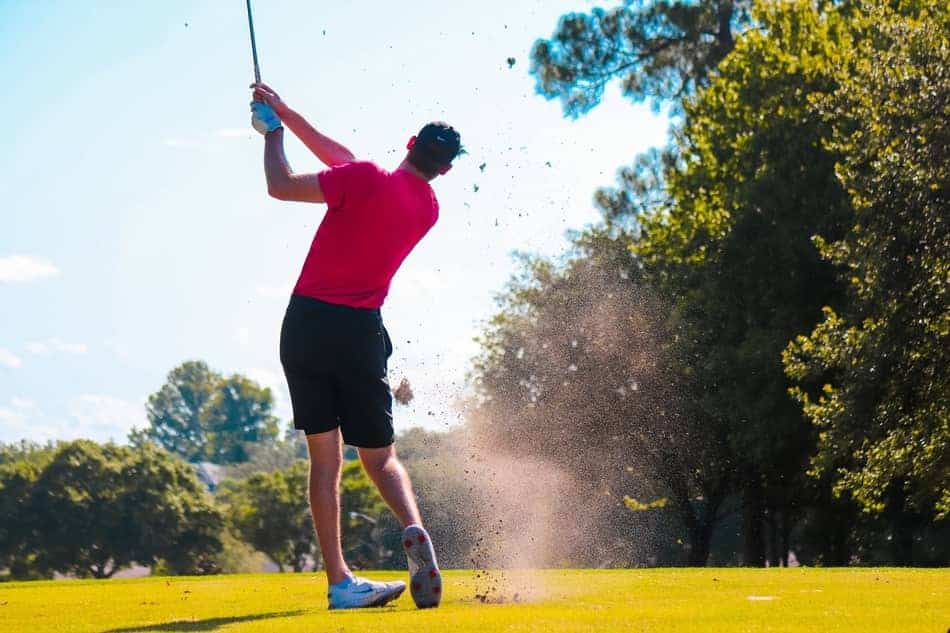
I’ve suffered from golfers’ elbow on a number of different occasions. Today I wanna share with you what I’m personally doing to fix this problem. That will include my whole routine and approach to golfers’ elbow.
Just to let you know you don’t have to play golf to get a golfer’s elbow. It’s just the term used to describe elbow tendonitis.
You have to understand that when you experience any pain during your workout, it’s not gonna cause you just the discomfort.
The pain signal shuts down the muscle activation.
So you don’t get the most of your workout.
I’m gonna give you some quick ideas on keeping this problem from happening again and getting you out of this pain hole.
Golfers elbow and tennis elbow are one of the most common problems in weight lifting, climbing, golfing, calisthenics, and pretty much everywhere you either pull yourself up or you rotate your elbows under the load or high speed.
The medical term for golfers elbow is medial epicondylitis and it’s usually manifested as a pain from the inside of the elbow joint. On the other hand, the tennis elbow is on the lateral side of the elbow.
The good news is that there are only a couple of reasons why you are experiencing this pain. Which helps to understand the situation much better.
Related article: Kettlebell Swings And Hindu Pushups At Home Workout
You’ve Changed Your Workout Routine
There is this saying that tendons don’t like change. This means when you introduce a sudden change to your workout routine or add significantly more intensity, that involves a high volume of pulling, grip or rotation, it can cause pain.
And once that demand isn’t tolerated by the tendon, you will feel discomfort. For example.
If you haven’t done any kettlebell work, and now all of a sudden all you do is the kettlebell swings, this can cause the temporary shock to the tendons.
In my case, when I started doing high volume pull-ups, immediately after a couple of weeks my elbows start to flare.
Also people who train in the split seasons for their sport. Like outdoor climbers. During the summer time they are active. But in the winter time not so much. They may do some training, but it’s nothing as close to the intensity as the summer work.
Related article: Can Kettlebell Swings Cause Neck Pain?
Long Break From Exercise
This is aligned with the first reason. People who had an injury, or who just been busy with their life, and couldn’t be consistent with their workouts, and now went straight back into it with a high volume, may experience some temporary discomfort.
It happened to me years back when I broke my left wrist. After being immobilized for months, I wanted to get back into swing as soon as possible. So psychologically, I thought I was in the same place prior to the injury. But physiologically, I was way behind.
Once you stop challenging your body under resistance, it will start the adaptation process.
It’s almost like your body is saying “He doesn’t use those muscles anymore, so there is no need to keep it.”
If you don’t use it, you lose it.
Remember that this won’t happen the very same day as you start lifting. It may take even a month or two to start feeling the symptoms.
Related article: Can I Do 50 Kettlebell Swings A Day?
Single Arm Kettlebell Swings
If you experience the pain from doing single-arm kettlebell swings then the most likely cause of the pain is the way you hold the kettlebell. In a heavy single arm swing you have much less shoulder stability, comparing to both arm swing.
And if the load is too challenging, you may find that you start to compensate but adding some unnecessary rotation from your shoulder, or from your wrist.
To fix that try to lower the weight on the kettlebell swing, or simply do both hand swing.
Both hand swing is less challenging on the muscles, but it creates better stability for your wrists and shoulders. This way you don’t stress your elbow and you can perform exercise pain-free.
Poor Shoulder Mobility
What if the problem starts from doing both arms swing. Then you need to look at your shoulder mobility
Often times elbow problem is not the actual reason why we have pain. We know that pain sits from the inside of the joint. But it doesn’t mean that that’s where the cause is.
You must look at the joints above and below the problem.
Just like the knee pain can be caused by poor hip mobility. If the hip is either too tight or too weak it will manifest and stress down to the knee.
Or if we have poor ankle biomechanics it will transfer into the knee. That’s why people who either pronate of supinate thier feet too much can suffer from knee pain.
Same with the elbow.
This means we can spend a lot of time trying to mobilize the joint, work on eccentric and stretching, but if the problem starts in the shoulder joint its like swimming agains the tide.
You take one step forward, and two steps back.
To express full range of motion in your shoulder, you need to be able to internally rotate, externally rotate, flex and extend.
And I know from my own experience, that this is something that I haven’t done for many years. I thought that as long as I can lift my shoulder over my head, that’s all I need for mobility.
I was wrong.
I never spend time to work on my shoulder mobility.
That manifested in my workout routine. I was doing pull-ps every day. The problem with doing pull-ups every day in a fixed bar position is that it doesn’t allow the elbow to fully rotate as I’m pulling myself up.
And over time that led to golfers elbow.
Same with kettlebell swings. If your shoulder is stiff, if you’re missing internal rotation, or if your shoulder leans forward, it will dictate to the elbow to compensate by creating unnecessary rotation.
And over time this will result in pain.
Down below I will show you how to mobilize the shoulders, but for now, the easy fix you could do is try to catch the kettlebell outside of the handle.
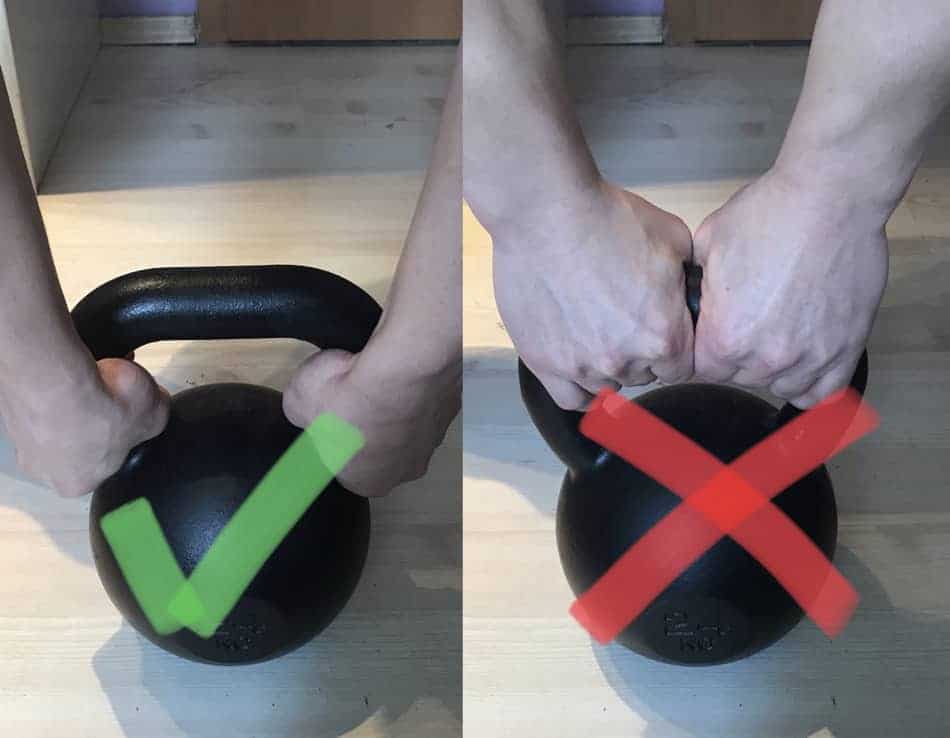
Poor Thoracic Spine Mobility
Poor joint mobility doesn’t always refer to ball and socket joint. It can also mean that your thoracic spine is stiff. That also include spinal kyphosis or lordosis.
And I’m not talking about the extreme cases.
I’m talking about the situations like work and lifestyle-related. Chronic sitting, prolonged driving, excessive use of mobile phones, and even cycling. All of that dictates the position of the spine.
That’s why in the mobilization we always start from the spine first. Because we can work on the shoulder mobility but if the spine is off, then we don’t get the most of the mobility work.
Spine dictates your position. And position will impact your movement.
So rounded upper back may not correlate the pain, but we know it correlates to a decrease in breathing efficiency, compromised diaphragm function, impair overhead ability, or even compromise pelvic floor dysfunction.
Remember that there are several ways to skin the cat so don’t just take in only my words. If you struggle with golfers elbow then most likely it’s because of one of those reasons.
Now the fix.
Eccentric Loading
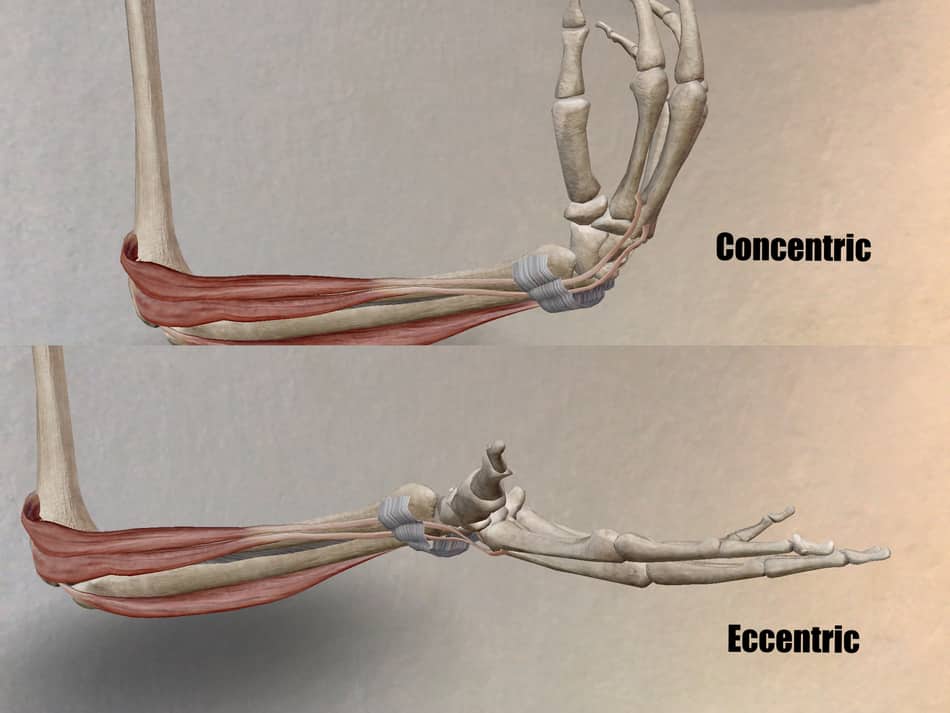
To strengthen the muscle each exercise is generally divided up into concentric and eccentric phases. In concentric exercises, the muscle contracts, and in eccentric exercises, the muscle stretches (relax).
Concentric exercise is when you hold a weight in your hand and pull it up towards your body.
Eccentric exercise means gradually lowering the weight and slowly working against gravity.
Eccentric loading is one of the most effective non-invasive ways to help strengthen the golfers’ elbow (source).
You do slow and control movement during the eccentric (lowering) phase. The goal of this exercise is to strengthen the forearm flexor muscles.
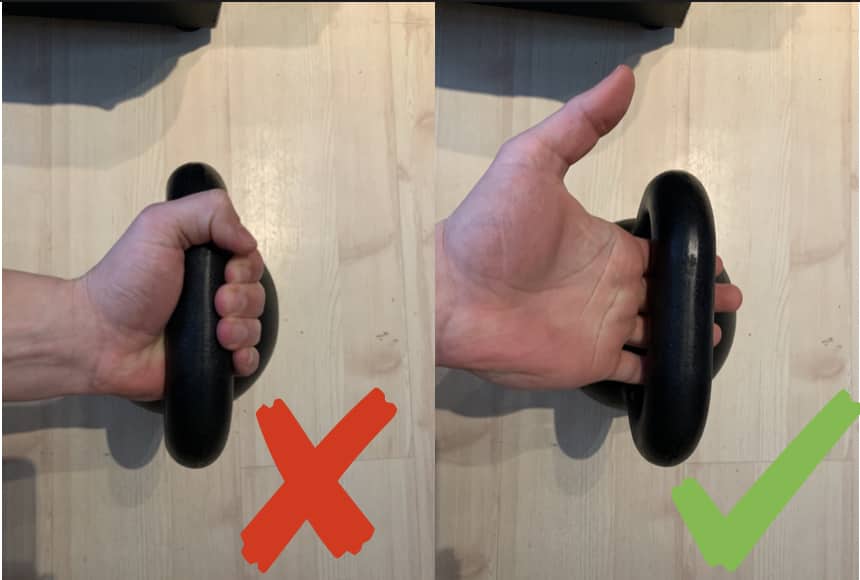
What to do:
- Hold a small weight in your hand. Don’t flex your hand to hold the weight. Let it stay on the fingers.
- Keep it supinated (palm facing upward).
- Sit comfortably.
- You can place your affected arm to rest on your thigh.
- Keep your elbow bent and your wrist stretched.
- Slowly lower the weight.
- For better results, just focus on the eccentric phase. You can use your other hand to help you bring the weight back up to the starting position.
- Do a total of 20 reps per set.
- Do a total of 3-4 sets per day.
Stretching
Apart from eccentric exercises to strengthen your forearm flexors you can also do some stretching.
The goal of stretching is to stretch and mobilize the wrist flexor area. This will help to relax the tension in the muscles. They will also improve your range of motion. You can add stretch to your daily routine.
Or it can be a part of your bodywork done by your massage therapist or physiotherapist.
What To Do:
- Place the affected arm on the flat surface with the palm facing downwards.
- Let the writs relax and fall back.
- With your other hand, gently pull the hand back towards your body. You should feel the stretch in your forearms.
- Hold the stretch for about 30 seconds.
- Repeat four times.
- Add contract-relax technique.
- Tighten up your affected hand as much as you can and hold it tight for 5-10 seconds.
- As you release the tension, now use your free hand to stretch.
Shoulder Mobility
Shoulder mobility is simply the expression of being able to move shoulder in its full range of motion. It include flexion, extension, internal rotation and external rotation.
When you spend some time and practice all of the corners, you will dramatically improve the position of the shoulder. And that will transfer to every exercise you do. Including swings.
For best results, I recommend to get the the monster band.
Internal Rotation
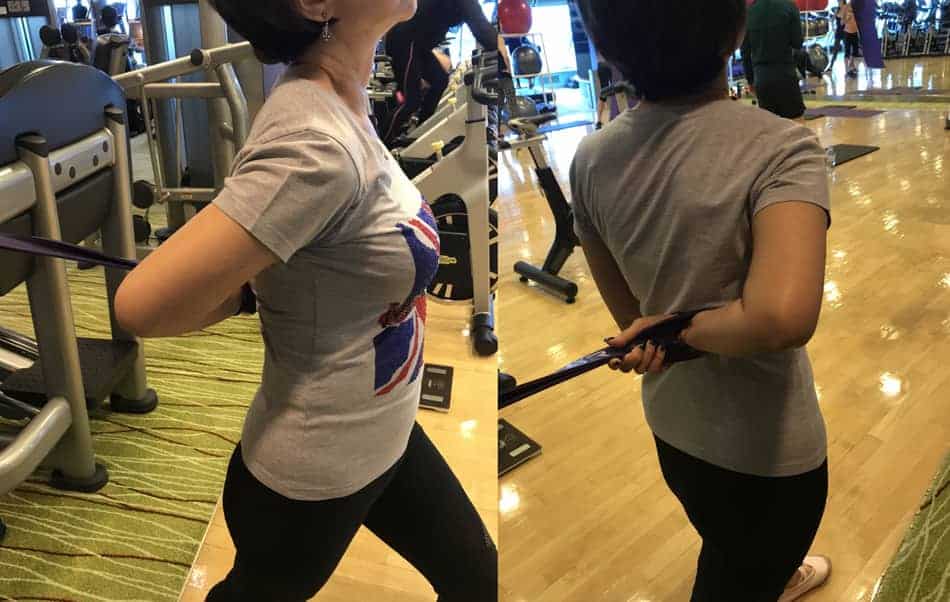
What To Do
- Strap the band against some stable object. It can be a fence or some pipe.
- Hold the band and wrap it around your wrist.
- Turn 180 degrees and step forward so the band stays behind you and develops the resistance.
- Bend your elbow and internally rotate your shoulder.
- Place the bent elbow behind your back.
- Push your chest up and slowly step forward so the band creates the additional pressure.
- Hold the stretch for 1-2 minutes and breath deeply
External Rotation
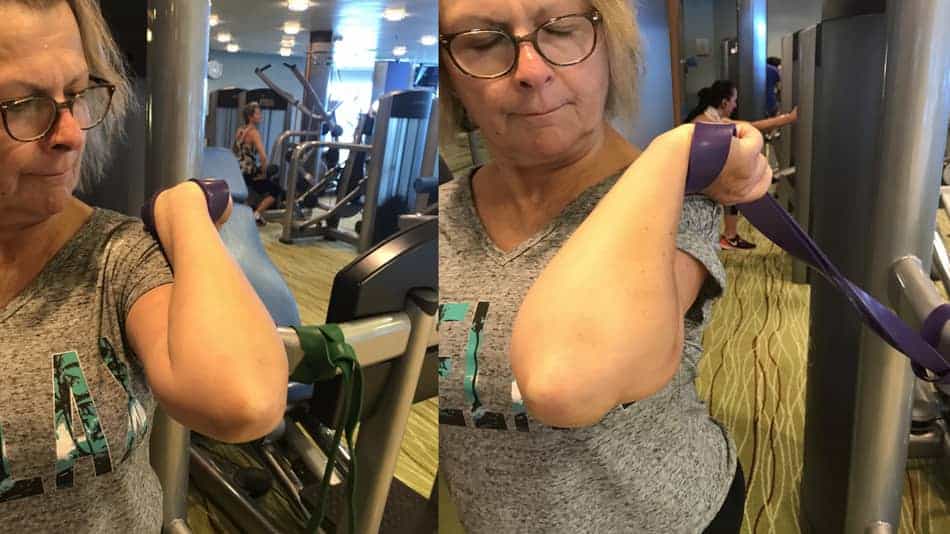
What To Do:
- Strap the band to some fixed object, like a fence or pipe.
- Wrap the band around your wrist.
- Rotate your shoulder externally and turn around 180 degrees. The bad should be behind you but above the shoulder.
- Position your hand just like a waiter is carrying plates.
- Step forward to create tension from the band.
- Hold for 1-2 minutes in a medium tension.
Related Questions
How long does it take to relief the pain?
To relieve the pain it can take anything from 6 days to even 6 months. It all depends on the severity of the situation. Once you get the pain, make sure to change your priorities and work around your problem. This may need to skip the swings for a moment and focus on more stable exercises.
What if the pain still continues?
If your symptoms continues contact with your doctor. This may be some underlying problem that you may not be aware of and doing set of testing like x-ray can help with diagnosis.
